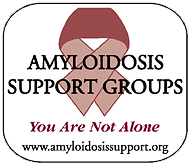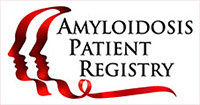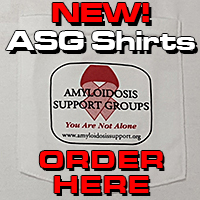
Home Page
Awareness Building
Amyloidosis Info
Amyloidosis Centers
ATTRwt & ATTRv
Important Clinical Trials
Patient Registry
Upcoming Events
Webinars
About Us
Contact Us
Resources
Treatment Centers
Awareness Items
AMY Blogs
Patient's Day
In Memoriam
Donations
Diflunisal Shortage!
Click Here
Were you diagnosed with Cerebral Amyloid Angiopathy (CAA)?
Click Here
|
Amyloidosis Support Groups
We are a phone call or email away! TOLL FREE HELP/HOT LINE: 866-404-7539 OR EMAIL: Info@amyloidosissupport.org |
Dr. Martha Skinner
Amyloid Treatment and Research Program
Boston University School of Medicine
Director, 1990-2007
Director of Special Projects, 2007-
Dear Friends,
I have been very fortunate to be part of medical progress from disease identification to treatment in the amyloidoses. After my training as a rheumatologist, I joined the faculty at Boston University School of Medicine and the Amyloid Program headed by Dr. Alan Cohen. At that time amyloidosis was a disease with varying clinical manifestations. Because the identification of the protein deposit had not been made, it was not known that there were actually different types of amyloidosis.
 Using an electron microscope, Dr. Cohen made the brilliant discovery that amyloid deposits were fibrils. This was of key importance because it meant that the fibrils could be isolated from tissue and identified. My research task was to work out procedures for purification and identification of amyloid proteins. The 1970s and early 1980s were years of protein discovery. Laborious technical work by us and others helped identify light chains in AL amyloidosis, AA protein in AA amyloidosis, and transthyretin (TTR) in the most common familial amyloidosis. Many other proteins were also found to cause amyloid deposits including fibrinogen, apolipoproteins A1 and A2, lysozyme, gelsolin, etc.
Using an electron microscope, Dr. Cohen made the brilliant discovery that amyloid deposits were fibrils. This was of key importance because it meant that the fibrils could be isolated from tissue and identified. My research task was to work out procedures for purification and identification of amyloid proteins. The 1970s and early 1980s were years of protein discovery. Laborious technical work by us and others helped identify light chains in AL amyloidosis, AA protein in AA amyloidosis, and transthyretin (TTR) in the most common familial amyloidosis. Many other proteins were also found to cause amyloid deposits including fibrinogen, apolipoproteins A1 and A2, lysozyme, gelsolin, etc.
In the 1980s clinical researchers matched patients' clinical findings with the protein type to discover the mechanism by which amyloid diseases were turned on. We learned so much from brave patients who were seriously ill and had no hope of treatment. We and other amyloid programs examined the natural history of each amyloid type, including patterns of organ system involvement and likelihood of survival. AL amyloidosis was found to be a bone marrow abnormality, AA amyloidosis was discovered to be secondary to inflammation of a serious nature, and the familial amyloidoses were found to be genetic diseases with a dominant inheritance pattern. Our laboratory and others developed ways to test for each disease type using clinical samples of biopsy tissues, blood, urine, and DNA. The generosity of patients was overwhelming! They allowed clinical samples to be studied in order to develop methods for diagnosis and to further research on understanding the disease patterns.
In the 1990s we could finally think about treatment. Once the pathogenesis of each amyloid disease was known, major treatments could be developed. The Swedish researchers were first with major treatment for TTR amyloidosis. In 1991 they performed a liver transplant on a patient to remove the factory making the abnormal TTR protein and give a new factory. This was a giant step forward and became a major treatment helpful to so many around the world. Yet it remains a very major surgical procedure with some risk, and optimal benefit requires the patient to be early in the course of disease.
High dose chemotherapy and stem cell transplantation (HDM/SCT) for AL amyloidosis was started in the mid 1990s. HDM/SCT as a treatment could be offered because technology had just been developed to collect stem cells from peripheral blood. The rationale was that a high dose of chemotherapy, given early in the disease, would kill the abnormal clone of plasma cells making light chain. Since chemotherapy killed other cells in the bone marrow too, stem cells were infused afterwards to make a new bone marrow. The success of this treatment was remarkable and patients with AL amyloidosis were getting better for the first time ever. However, the treatment comes with a cost; it is aggressive and has risks and can only be given if heart and other involvements are not too severe. Newer treatments are being developed.
Finally, in the 2000s the outlook is shifting to hopeful. Dedicated patients and research teams along with amazing technical scientific advances are changing the outlook for patients diagnosed with amyloidosis. This will be the decade of "smart treatments". For AA amyloidosis, the Neurochem Company has developed the first ever targeted inhibitor treatment with the drug, Kiacta. Patient participation in an international clinical trial has shown it effective (Dember, et al New Eng J Med, 2007). For AL amyloidosis new non-chemotherapy drugs are in clinical trials with promising early results to add to other treatments. For familial TTR amyloidosis, the NIH and FDA are supporting an international Diflunisal Trial, a targeted inhibitor of abnormal TTR fibril formation that we are excited about. More treatments and trials will be on the way…
Lastly, I want to give a special thanks to patients. They made a difference! Because of their willing participation in research and clinical trials we are now shifting to hopeful. Thank you.

2023 ATTR CHICAGO MEETING
WEBINARS (Virtual Meetings)
Arizona (Phoenix)
California (Los Angeles)
California (San Diego)
Chicago
Colorado
Detroit
Florida (Jacksonville)
Florida (Miami)
Florida (Tampa)
Georgia/Alabama
Indianapolis
Kansas City
Louisiana
Maryland (Baltimore/D.C.)
Maryland (Hagerstown)
Massachusetts
Minnesota
Nevada
New York City
New York (Rochester)
North Carolina
OSU/Cleveland Clinic
Philadelphia
Portland
St. Louis
South Carolina
Texas (Dallas)
Texas (Houston)
Utah
Virginia
Washington (Seattle)
Washington (Spokane)
Washington DC
|
We invite our pharmaceutical liaisons to our support group meetings to help in our goal of educating and empowering our patients. The donations and/or grant received from these companies are unconditional, and the ASG does not endorse any one of their products over any other types of amyloidosis treatment. These treatments are mentioned at our meetings, on our website, and other electronic format for educational purposes. We encourage you to consult your amyloidosis professional when choosing a treatment plan. |

